Exploring Palace Rooms in Schönbrunn Palace
What you will see on the Imperial tour and the Grand tour!
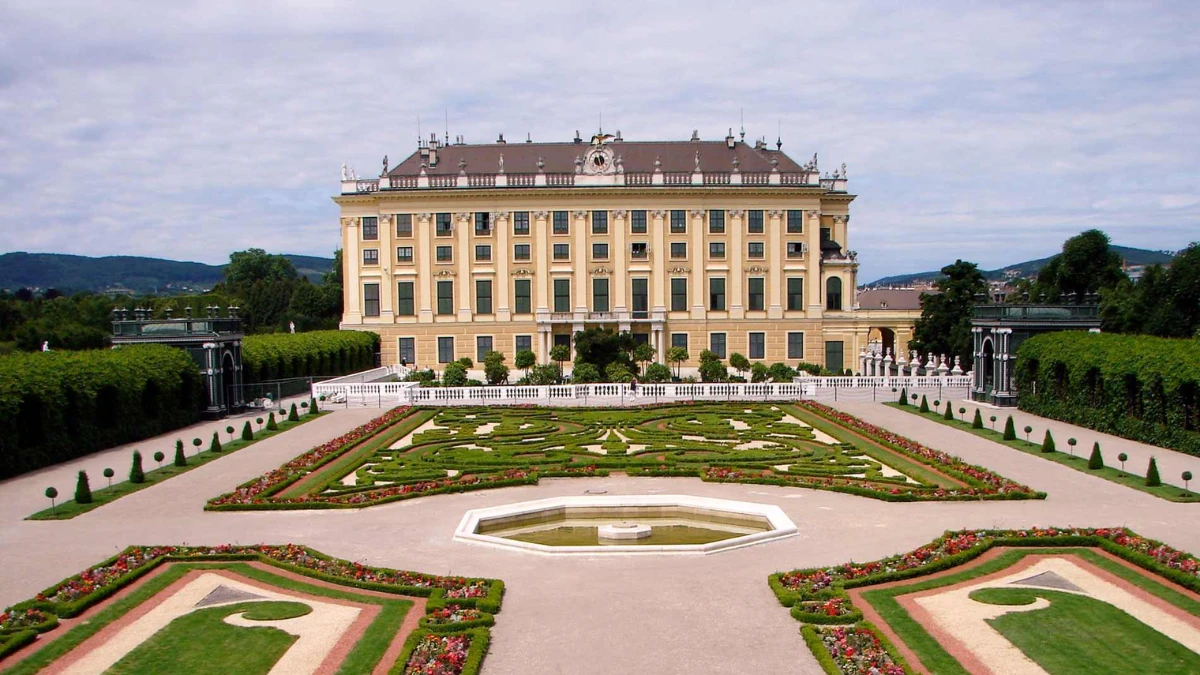
Did you know Schönbrunn Palace has a staggering 1,441 rooms? Of those, only 40 are open to visitors, but trust us, they’re the ones that matter most.
As you walk through them, you’ll move from glittering ballrooms to Emperor Franz Joseph’s humble bedroom, getting a real feel for both the glamour and the everyday life of the Habsburgs.
Choose between the Imperial tour or a Grand Tour of the palace and experience the king-sized life first-hand.
Download the Schonbrunn Palace Map (701 kb, PDF)
Choose from these tickets to visit Schonbrunn Palace rooms:
# Skip-the-Line Schönbrunn Palace and Gardens Tour
# Skip-the-Line Schonbrunn Palace Private Tour
# Schönbrunn Palace Evening Tour, Dinner and Concert
# Skip-the-line Ticket to Schonbrunn Palace with Audio Guide
Number of rooms inside the Schönbrunn Palace
There are a total of 1441 rooms, out of which 40 rooms are accessible to visitors on the first floor of the palace.
Here is a layout of the room numbers (1 to 40) that are part of the visit:
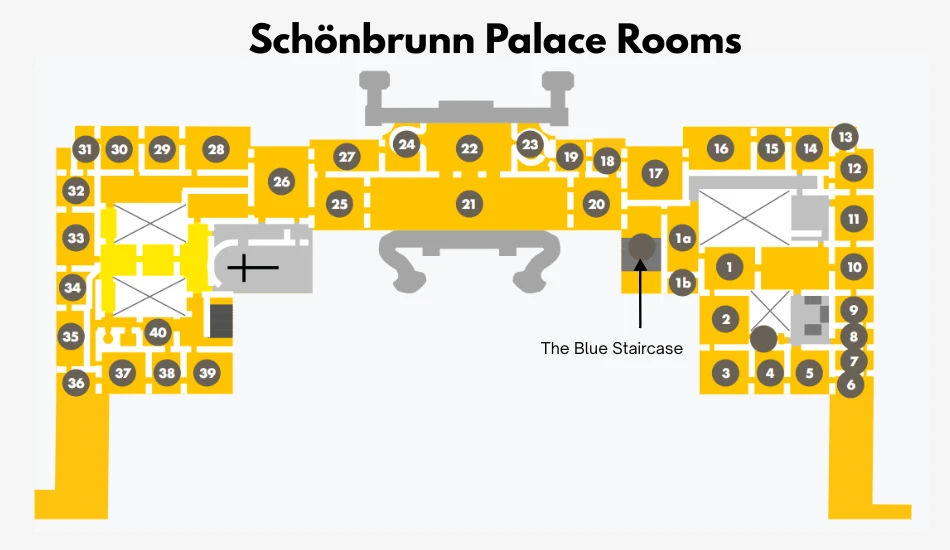
Types of rooms in the Palace
These palace rooms fall into three main categories:
Before you step into the palace rooms, take a moment to check the opening hours, read up on handy visitor tips, and see if there’s a dress code so that you can enjoy every detail without any surprises.
The State Rooms at Schönbrunn Palace
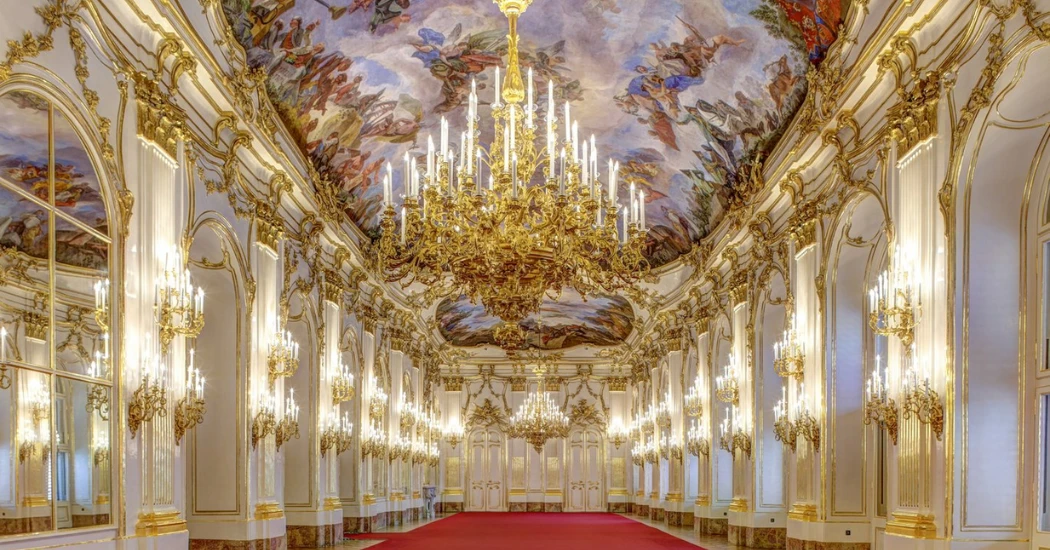
The State Rooms at Schönbrunn Palace were the epicenter of official functions and ceremonies for the Habsburg monarchy.
These magnificent rooms were used to entertain dignitaries, host imperial events, and carry out state affairs.
Today, they remain open to the public, offering a fascinating glimpse into the grandeur and political power of the Habsburg dynasty.
“To visit the State Rooms, you must book the Grand Tour ticket, which covers 40 rooms, including the private apartments and ceremonial halls.”
Highlights of the State Rooms:
Location: The State Rooms are spread across the central part (room number 17 to 27) of the palace, primarily on the principal floor (piano nobile). These rooms are accessible via the grand Blue Staircase.
Room Numbers: 17, 18, 19, 20, 21, 22, 23, 24, 25, 26, 27
Decor and style: The State Rooms mix Baroque, Rococo, and Empire styles with ornate furniture, grand chandeliers, gilded frames, and frescoes. Gold and red colors, marble, and stucco details create a luxurious, regal atmosphere for imperial events. Learn more.
Functionality: Each room serves a specific ceremonial function, from royal audiences to lavish balls and receptions. These rooms were designed not just to impress, but to convey the authority and power of the imperial family.
Time Required: Set aside at least 25 to 40 minutes to explore the State Rooms during your visit. If you’re using the audio guide or on a guided tour, you may want to spend more time in each room to appreciate the intricate details.
| Room Number | Room Name |
| 17 | Large Rosa Room |
| 18 | Second Small Rosa Room |
| 19 | First Small Rosa Room |
| 20 | Lantern Room |
| 21 | Great Gallery |
| 22 | Small Gallery |
| 23 | Round Chinese Cabinet |
| 24 | Oval Chinese Cabinet |
| 25 | Carousel Room |
| 26 | Hall of Ceremonies |
| 27 | Horses Room |
Did You Know?
The State Rooms were not only used for grand ceremonies but also for intimate, powerful moments. For example, the Audience Chamber was where Emperor Franz Joseph met with dignitaries and made key decisions that shaped the future of the empire.
Top 3 State Rooms you shouldn’t miss
- Great Gallery – The grand ballroom for imperial dances and banquets.
- Millions Room – Decorated with rare rosewood and Indo-Persian miniatures.
- Hall of Mirrors – Where young Mozart performed before Empress Maria Theresa.
Crowd Tip:
Visit the State Rooms early in the morning or late in the afternoon to avoid large tour groups. Booking skip-the-line Grand Tour tickets is highly recommended during peak seasons.
⭐Get more such amazing tips for a smoother visit!
The Private Rooms at Schönbrunn Palace (Imperial Rooms)
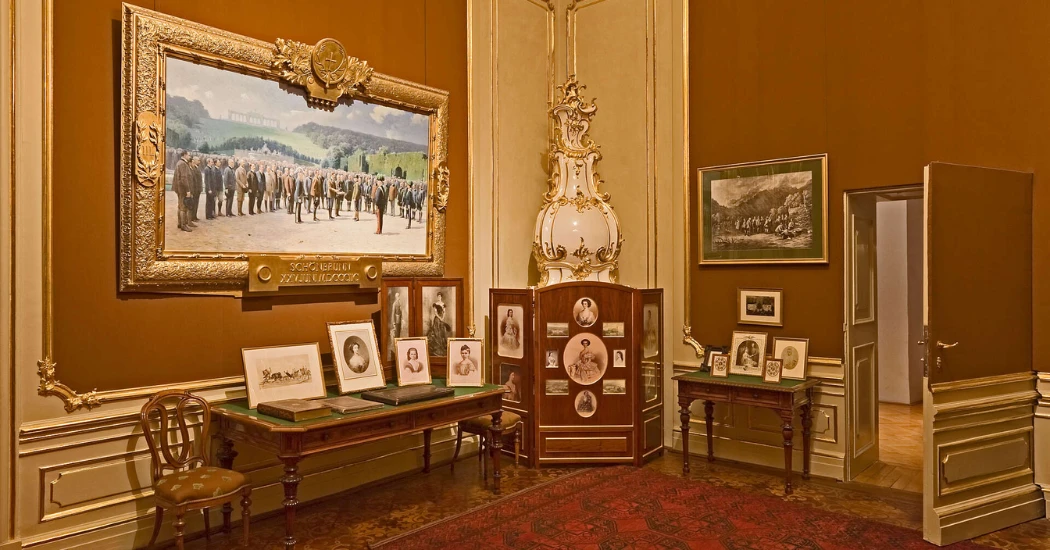
The Private Rooms at Schönbrunn Palace offer a deeply personal glimpse into the everyday lives of the Habsburgs.
Unlike the grand ceremonial halls, these spaces were not meant to impress; they were lived in.
These rooms housed the personal routines, habits, and quiet moments of Emperor Franz Joseph, Empress Elisabeth (Sisi), and other members of the imperial family.
“The Private Rooms are included in both the Imperial Tour (22 rooms) and the Grand Tour (40 rooms), making them a core part of any Schönbrunn Palace visit.”
Highlights of the State Rooms:
Location: The Private Rooms are located primarily in the west wing of the palace, directly accessible from the Blue Staircase. They are part of the first half of the tour and reflect a more subdued, human side of royal life, in contrast to the grandeur of the State Rooms.
Explore Schonbrunn Palace maps to get proper directions.
Room Numbers: 1a, 1b, 1, 2, 3, 4, 5, 6, 7, 8, 9, 10, 11, 12, 13, 34, 35, 36, 38, 39, 40
Decor and style: The Private Rooms feature a simpler decor, characterized by clean lines, modest furniture, and minimal ornamentation. Franz Joseph was famously frugal, and his rooms reflect practicality rather than splendor. You’ll notice a stark contrast between the luxury of the ceremonial spaces and the restrained, almost austere feel of these living quarters.
Functionality: These rooms served as the Emperor’s and Empress’s actual bedrooms, studies, dining areas, and lounges. From work to rest, they were used daily. Emperor Franz Joseph began his day at 5 am in his study and worked until night. His desk and military uniform are still on display today.
Time Required: It takes about 20 to 30 minutes to explore the Private Rooms, depending on the size of your group and whether you pause at each station with the audio guide.
| Room Number | Room Name |
| 1a | Antechamber |
| 1b | Aides-de-Camp Room |
| 1 | Guards Room |
| 2 | Billiard Room |
| 3 | Audience Chamber |
| 4 | Emperor Franz Joseph’s Study |
| 5 | Franz Joseph’s Bedroom |
| 6 | Western Terrace Cabinet |
| 7 | Stairs Cabinet |
| 8 | Dressing Room |
| 9 | Imperial Couple’s Bedroom |
| 10 | Salon of Empress Elisabeth |
| 11 | Marie Antoinette Room |
| 12 | Salon of the Archduchess Portraits |
| 13 | Breakfast Cabinet |
| 34 | Archduchess Sophie’s Study |
| 35 | Red Salon |
| 36 | Eastern Terrace Cabinet |
| 38 | Study of Archduke Franz Karl |
| 39 | Salon of Archduke Franz Karl |
| 40 | Hunting Room |
Did You Know?
Franz Joseph’s iron bed is so small and simple, many visitors are shocked by its humility — yet he slept in it until the day he died. Sisi, on the other hand, disliked palace life and spent much of her time traveling, though her personal rooms here reflect her elegance and independence.
Top 3 Private Rooms to look out for
- Franz Joseph’s Study – Modest and efficient, where he ran daily state affairs.
- Imperial Couple’s Bedroom – A symbol of duty more than romance.
- Salon of Empress Elisabeth – Her personal retreat, decorated with delicate touches.
Crowd Tip:
These rooms come first on the tour route and can get crowded quickly. If you want to enjoy them in peace, arrive right when the palace opens or book the earliest time slot available.
The Special Rooms at Schönbrunn Palace
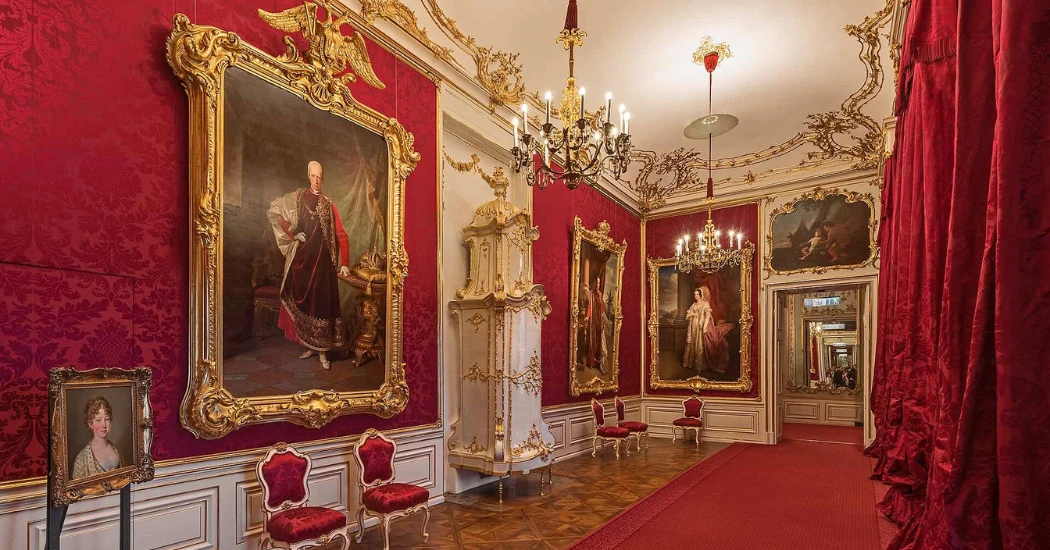
While the State Rooms showcase imperial grandeur and the Private Rooms reveal royal routines, the Special Rooms at Schönbrunn Palace are where personality, artistry, and uniqueness take center stage.
These spaces were designed with rare materials, unique themes, or highly personal purposes, making them true treasures of the palace.
“The Special Rooms are included in the Grand Tour (40 rooms), not the Imperial Tour. If you want to explore these extraordinary spaces, be sure to book the full-access Grand Tour ticket.”
Highlights of the State Rooms:
Location: The Special Rooms are located throughout the central and eastern parts of the palace. Many are tucked between state halls and ceremonial rooms, revealing themselves like hidden gems. Some of the most famous Special Rooms are grouped near the State Rooms, while others are connected to transitional galleries and personal salons.
Room Numbers: 14, 15, 16, 28, 29, 30, 31, 32
Decor and style: What makes these rooms “special” is their unusual decor, rare materials, or thematic designs. Think lacquered Chinese panels, intricate tapestries, gilded carvings, and exotic furnishings. These rooms reflect the imperial family’s love for fine craftsmanship, global influences (especially Asian art), and collecting rare artifacts.
Functionality: Each Special Room had a distinctive purpose. Some were used for quiet diplomacy, others for private entertainment, and some simply to impress with artistry and taste. These were often not functional spaces like bedrooms or studies — they were meant to display culture, refinement, and exclusivity.
Time Required: Expect to spend around 15 to 20 minutes exploring the Special Rooms, especially if you pause to admire their details and listen to the audio commentary.
| Room Number | Room Name |
| 14 | Yellow Salon |
| 15 | Balcony Room |
| 16 | Hall of Mirrors |
| 28 | Blue Chinese Salon |
| 29 | Vieux Laque Room |
| 30 | Napoleon Room |
| 31 | Porcelain Room |
| 32 | Millions Room |
| 33 | Gobelin Salon |
| 37 | Rich Room |
Did You Know?
The Millions Room got its name because the exotic wood and miniature paintings inside were so rare and costly that their value was said to run into the millions, even in the 18th century.The Round Chinese Cabinet was reserved for secret diplomatic conversations held under candlelight, far from the public eye.
Top 5 Special Rooms to look out for
- Millions Room – Decorated with rare rosewood and Indo-Persian miniatures; one of the most expensive rooms in Europe.
- Porcelain Room – Painted to imitate blue-and-white Chinese porcelain; elegant and delicate.
- Round Chinese Cabinet – Used for secret meetings, featuring black lacquer panels and chinoiserie.
- Oval Chinese Cabinet – Companion to the round cabinet, richly adorned with similar Asian art.
- Napoleon Room – Named after Napoleon Bonaparte, who stayed here during his occupation of Vienna.
Crowd Tip: Because these rooms are midway through the Grand Tour, crowds tend to pause here. If you’re visiting during peak season, consider booking the earliest or latest time slots to enjoy them quietly.
